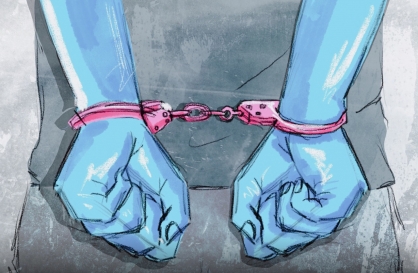Peranakan: When China meets Southeast Asia, West
Exhibition on Singapore's cultural mix held for first time at National Museum
By Korea HeraldPublished : March 19, 2013 - 19:31
Multicultural families have always existed as humans moved about, found love and settled in places far away from home.
“Peranakan” loosely translates as “local-born” in the Malay language. They are the descendants of Southeast Asians and “outsiders,” mainly from China, who settled in Myanmar, Indonesia, Malaysia and Singapore, and have, over the past five centuries, formed a unique culture.
Many of them rose to leadership roles in society as they accumulated wealth through trade and commerce, and created a community of their own. Lee Kuan Yew, the first prime minister of Singapore, was a Peranakan.
At the National Museum of Korea, the “Peranakan World: Cross-cultural Art from Singapore and the Straits,” running in the special exhibition gallery until May 19, portrays the essence of the Chinese Peranakans’ lives and culture in Singapore.
“Peranakan” loosely translates as “local-born” in the Malay language. They are the descendants of Southeast Asians and “outsiders,” mainly from China, who settled in Myanmar, Indonesia, Malaysia and Singapore, and have, over the past five centuries, formed a unique culture.
Many of them rose to leadership roles in society as they accumulated wealth through trade and commerce, and created a community of their own. Lee Kuan Yew, the first prime minister of Singapore, was a Peranakan.
At the National Museum of Korea, the “Peranakan World: Cross-cultural Art from Singapore and the Straits,” running in the special exhibition gallery until May 19, portrays the essence of the Chinese Peranakans’ lives and culture in Singapore.

“Peranakan culture defies easy classification. It has clear elements of Chinese identity as well as components of the Malay world. Moreover, the cultures of the Indian Ocean have also left their marks, as have the colonial trading networks of the Portuguese, the Dutch and the British. New languages, cuisines, ways of dressing, social customs, as well as distinct artistic forms arose from these fusions,” said Alan Chong, director of the Asian Civilizations Museum and the Peranakan Museum, at a press briefing Monday. His museums provided the exhibited items.
“The Peranakans thus provide an example for looking at the world: They remind us to look beyond the strict notions of nationality and ethnicity to discover the value of diverse and open societies.”
Chinese style wedding
Like many other Asians, Peranakans value marriage, which is one of the most important events in one’s life, uniting one family with another. A wedding would usually take 12 days and shared the different aspects of both families’ wealth and customs.
The bride wore colorful robes, a headdress and headbands, which were used not only to beautify, but also to boast of the wealth of her family and pay respect to the in-laws.
The wedding chamber was adorned with various symbols wishing for longevity, harmony and happiness such as the phoenix, butterflies and peonies following Chinese custom. The color red, considered auspicious in Chinese culture, was diluted to pink in the Peranakan culture and displayed as the main color in the bedroom.
Gradually the multicultural Chinese descendants accepted European styles, such as Irish carpets woven with peacock patterns and Westernized decor introduced in the early 20th century.
In the Peranakan culture, women are called “nyonya” and men “baba.” Women dressed in sarong kebaya, loose blouses, or baju panjang, a long tunic. Three brooches were used to hold the tight-fitting wrap skirts with complicated and sophisticated patterns. To this day, many nyonyas wear baju panjang on special occasions.
Porcelain, beadwork and embroidery
Beadwork and embroidery were the signature arts of the Peranakan culture.
Beadwork was used for accessorizing slippers, garments, jars and other products. Women played an important role ― many families wanted women members who were good sewing and handicraft. Some of these items were imported from China or created by local craftsmen, but it was mostly women in the family who were in charge of beadwork and embroidery.
A labor-intensive activity, creating elaborate works with beads or embroidery was costly. These works became symbols of wealth and were shown off at weddings and other important occasions. They were also required as wedding dowry.
Beadwork panels with animals and flowers are perhaps the largest glass bead craft in the Peranakan culture. The 26.8-centimeter-wide and 50-centimeter-long panel on display is composed mainly of three colors ― turquoise, pink and yellow ― which all represent happiness and fortune.
Westernization
From the 19th century on, wealthy Peranakans became heavily influenced by Westernized civilization. Men were taught at Western schools, enjoyed tennis, cricket or held balls and banquets. They lived in Westernized houses and drove diesel engine cars. They took photographs, which were not so common at the time, or commissioned portraits.
Some of them adopted the idea of philanthropy and established local hospitals, schools or nursing homes, which often led them to work for the colonial government as public officials.
The public officialdom sometimes allowed them more business opportunities, allowing them to enjoy even greater wealth. Many Peranakans were proud of their heritage and were sometimes mocked as the “King’s Chinese people.”
“Many of them were proud of their wealth, their social status and heritage. They have held core positions in society and still do. Studying Peranakan is therefore important in understanding the region,” said Park Sung-hye, curator of the exhibition.
By Bae Ji-sook (baejisook@heraldcorp.com)
-
Articles by Korea Herald





![[KH Explains] No more 'Michael' at Kakao Games](http://res.heraldm.com/phpwas/restmb_idxmake.php?idx=644&simg=/content/image/2024/04/28/20240428050183_0.jpg&u=20240428180321)




![[Grace Kao] Hybe vs. Ador: Inspiration, imitation and plagiarism](http://res.heraldm.com/phpwas/restmb_idxmake.php?idx=644&simg=/content/image/2024/04/28/20240428050220_0.jpg&u=)









